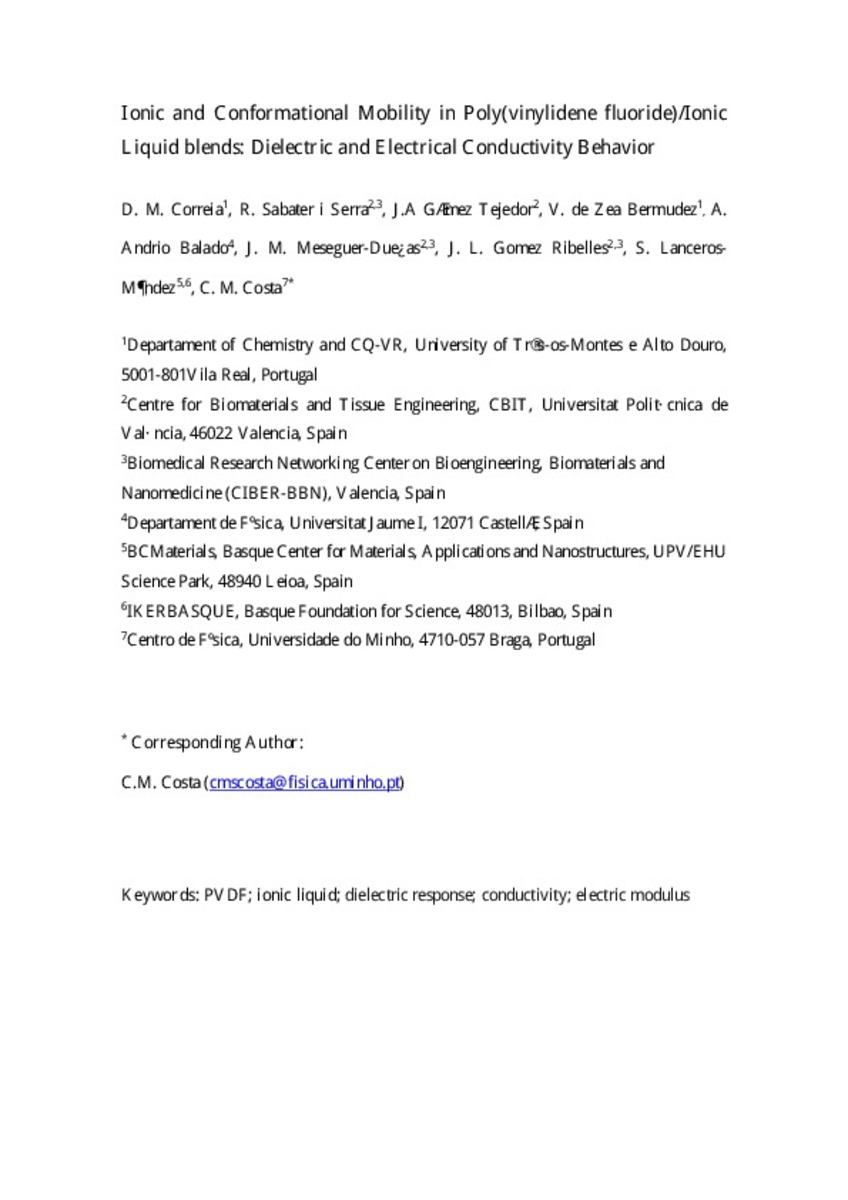Mostrar el registro sencillo del ítem
Ionic and conformational mobility in poly(vinylidene fluoride)/ionic liquid blends: Dielectric and electrical conductivity behavior
| dc.contributor.author | Sabater Serra, Roser | |
| dc.contributor.author | Gómez Tejedor, J. A. | |
| dc.contributor.author | Correia, D. M. | |
| dc.contributor.author | De Zea Bermúdez, Verónica | |
| dc.contributor.author | Andrio, Andreu | |
| dc.contributor.author | Meseguer Dueñas, José María | |
| dc.contributor.author | Gomez Ribelles, Jose Luis | |
| dc.contributor.author | lanceros-mendez, senentxu | |
| dc.contributor.author | Costa, C. M. | |
| dc.date.accessioned | 2019-02-19T10:16:01Z | |
| dc.date.available | 2019-02-19T10:16:01Z | |
| dc.date.issued | 2018 | |
| dc.identifier.citation | CORREIA, D. M., et al. Ionic and conformational mobility in poly (vinylidene fluoride)/ionic liquid blends: Dielectric and electrical conductivity behavior. Polymer, 2018, vol. 143, p. 164-172. | ca_CA |
| dc.identifier.issn | 0032-3861 | |
| dc.identifier.uri | http://hdl.handle.net/10234/181258 | |
| dc.description.abstract | The glass transition dynamics and the charge transport for blends composed of poly(vinylidenefluoride)(PVDF) and the ionic liquid (IL) 1-ethyl-3-methylimidazolium bis(trifluoromethylsulfonyl) imide, [Emim][TFSI] have been investigated as a function of different IL content (0, 10, 25 and 40 % wt) by differentialscanning calorimetry (DSC), dynamic-mechanical analysis (DMA) and broadband dielectric relaxationspectroscopy (BDS) in wide frequency and temperature ranges (0.1 Hze1 MHz and 120 to 150 C,respectively). The inclusion of the IL in the polymer matrix affected the main relaxation process (b-relaxation) of the amorphous phase of the polymer matrix detected with all the techniques employed. Itis demonstrated, that the chain segments of PVDF and the IL are mixed at the nanometer range. Theblends were homogeneous regardless of the amount of IL and the glass transition temperature (Tg)shifted to lower temperatures as the IL content was increased. A good agreement between the Tgmeasured by BDS and DSC was observed for all PVDF/IL samples. The conductivity formalism revealedsignificant contributions of the IL concentration to the conductivity behavior of the blends in that isdescribed by charge motion and electrode polarization effects. The activation energy of all the PVDF/ILsamples, calculated by Dyre model, decreased with IL addition with respect to that of neat PVDF. | ca_CA |
| dc.format.extent | 9 p. | ca_CA |
| dc.language.iso | eng | ca_CA |
| dc.publisher | Elsevier | ca_CA |
| dc.relation.isPartOf | Polymer 143 (2018) | ca_CA |
| dc.rights | 0032-3861/©2018 Elsevier Ltd. All rights reserved | ca_CA |
| dc.rights.uri | http://rightsstatements.org/vocab/InC/1.0/ | * |
| dc.subject | PVDF | ca_CA |
| dc.subject | Ionic liquid | ca_CA |
| dc.subject | Dielectric response | ca_CA |
| dc.subject | Conductivity | ca_CA |
| dc.subject | Electric modulus | ca_CA |
| dc.title | Ionic and conformational mobility in poly(vinylidene fluoride)/ionic liquid blends: Dielectric and electrical conductivity behavior | ca_CA |
| dc.type | info:eu-repo/semantics/article | ca_CA |
| dc.identifier.doi | https://doi.org/10.1016/j.polymer.2018.04.019 | |
| dc.relation.projectID | UID/FIS/04650/201 ; DC/CTM-ENE/5387/2014, PTDC/EEI-SII/5582/2014 and UID/CTM/50025/2013 and Grants SFRH/BPD/121526/2016 (D.M.C.), SFRH/BPD/112547/2015 (C.M.C.). ; MAT2016-76039-C4-3-R (AEI/FEDER, UE | ca_CA |
| dc.rights.accessRights | info:eu-repo/semantics/openAccess | ca_CA |
| dc.relation.publisherVersion | https://www.sciencedirect.com/science/article/pii/S0032386118303069 | ca_CA |
| dc.type.version | info:eu-repo/semantics/submittedVersion | ca_CA |
Ficheros en el ítem
Este ítem aparece en la(s) siguiente(s) colección(ones)
-
FCA_Articles [511]
Articles de publicacions periódiques







